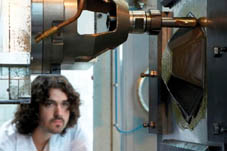渐进板材成形(ISF)是通过连续局部变形的金属成形。它是形成三维薄壳的实用方法,金属性能对于许多用途都是令人满意的。ISF潜在地是一种很有用的板材成形工艺,但在金属加工业中几乎没有什么应用,仅仅是因为在现实中通常实现不了最佳的机械性能。
Incremental sheet forming (ISF) is a term describing a set of sheet metal forming methods. It is an alternative to metal pressing or stamping. ISF is suitable for large variety of products without major changes or expensive investments because an indentor tracks round the workpiece, creating small kinks in the material, incrementally developing any chosen shape. This leads to lower production rates but no tooling costs, and is potentially an attractive solution for flexible low-volume manufacturing. This process is interesting with regard to the manufacturing of prototype parts since the forming is carried out without any specific tools. The forming process, when carried out on a lathe, resembles the spinning process, but the process can also be carried out on a NC machining center and it then becomes possible to form non-symmetric complex sheet metal parts. The process only requires a fixture in which the blank is mounted and a NC program to drive the forming tool. Montes srl, a company based in Europe, claims to be the first to propose sheet metal forming using the innovative incremental forming technology. The company makes prototypes and small batches of pieces in carbon steel, stainless steel, aluminum alloys, brass, copper, notably reducing the costs for making moulds. Prototyping technique Prototyping methods for sheet metal products in literature are related to rapid tooling, where traditional hard dies are replaced with softer and more inexpensive short lifetime dies. Direct sheet metal prototyping methods have been very few, and their use has been limited. Prototyping is an important part of product development process. Prototypes are used in product development process for several reasons: learning, communication, illustrating and verifying. Visual model can help to understand the ideas of other project group members and check the movements of different parts. This can be achieved with a mock-up prototype or a prototype made of different material or with different methods than the actual product. Another application of prototypes is testing a part's suitability for certain position in assembly and environment of use. Several tests are required for standardization and selling permits. These tests usually have to be done using the actual production geometry and materials and often the actual production method. When using sheet metal components, this requires appropriate prototyping methods. Convex surface forming The variations of ISF can be divided into categories such as forming of the convex surface or the concave surface. The convex surface forming was the first variation of ISF. It is known as 揇ieless NC Forming? and was introduced in Japan by Matsubara in 1993 as a method for prototyping and manufacturing sheet metal products in short series. The method was originally developed for the needs of car manufacturers but now it is used by several other industries as well. This is also the only commercially availablenike
Prototyping methods for sheet metal products in literature are related to rapid tooling, where traditional hard dies are replaced with softer and more inexpensive short lifetime dies. Direct sheet metal prototyping methods have been very few, and their use has been limited. Prototyping is an important part of product development process. Prototypes are used in product development process for several reasons: learning, communication, illustrating and verifying. Visual model can help to understand the ideas of other project group members and check the movements of different parts. This can be achieved with a mock-up prototype or a prototype made of different material or with different methods than the actual product. Another application of prototypes is testing a part's suitability for certain position in assembly and environment of use. Several tests are required for standardization and selling permits. These tests usually have to be done using the actual production geometry and materials and often the actual production method. When using sheet metal components, this requires appropriate prototyping methods. Convex surface forming The variations of ISF can be divided into categories such as forming of the convex surface or the concave surface. The convex surface forming was the first variation of ISF. It is known as 揇ieless NC Forming? and was introduced in Japan by Matsubara in 1993 as a method for prototyping and manufacturing sheet metal products in short series. The method was originally developed for the needs of car manufacturers but now it is used by several other industries as well. This is also the only commercially availablenike













